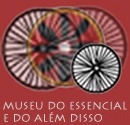Read
about the museum project / 2002
The electronic magazine Arte on Line was first published in September 2000 in an almost amateur effort by its editor, the researcher and visual artist Regina Célia Pinto. Despite that, however, it has been very successful - the site has received numerous visitors and several favorable emails, demonstrating that its contents are being well received. Therefore, we published a proposal for producing a total of five issues in the second edition, launched in January 2001. As a result, the magazine became more professional and two more editors from Rio de Janeiro came on board - Marcelo Frazão and Paulo Villela - as well as countless collaborators from several parts of Brazil and the world. One of them is Jorge Luiz Antonio, from São Paulo, who always showed a keen interest and made excellent suggestions, and became a publications consultant to the magazine.
Foremost among our international collaborators was Reiner Strasser, a German from Wiesbaden. He and Jorge Luiz Antonio publicized our publication in the Webartery list compiled by Jim Andrews, from Canada, who later on honored us with a link in his well-known site http://www.vispo.com. In Spanish-speaking countries, much of our success was due to the sensitive and amiable Uruguayan poet Clemente Padim. He was introduced to us by Neide Dias de Sá and Álvaro de Sá, from Rio de Janeiro, who also helped us with their knowledge of experimental poetry and the book-object.
That is how a very serious Brazilian magazine that has never been connected to a university, much less had financial support or sponsorship of any kind, developed on a modest home computer in Rio de Janeiro, reached the first world and won respect, garnering, among others, a link in the E-poetry 2001 Festival, a reference point for poetry in academia. Furthermore, its fourth edition was hailed as the website of the month of January by the University of Mississippi. At the same time, Brazilian college professor Diana Domingues, who wrote the well-known book Arte e Tecnologia no século XXI (Art and Technology in the 21st Century) honored us by sending Arte on Line no. 3 an article on the INSN(H)AK(R)ES project she is developing along with artists and scientists at the Universidade de Caxias do Sul.
Through the Borders Project, launched in Arte on Line no. 3, we also gained knowledge and publicized the work of Joéser Alvarez, an artist from the Brazilian Amazon who uses the digital in an extremely contemporary manner and lives in Porto Velho, Rondônia.
These facts alone demonstrate that our original proposal was on the mark when we wrote that publishing an art magazine in the conventional way would involve high costs and reach a very limited readership. We said that it would be opportune and very contemporary to publish a magazine on art on the Web. This publication's particularity would be the absence of borders. It would contain articles, essays, works and interviews with artists and critics from around the world, irregardless of whether they came from the first world or the third. Our selections would always be based on the essential criteria of contemporaneity and quality.
The proposal developed in November and December 2000 was justified as follows:
One of the pathways of contemporary art is increasingly followed but still little studied: the twinning of Art and Technology. Most artists and the general public are unaware that, much more than a tool, computers are giving rise to new artistic languages. And Arte on Line will always invest in these languages and the contemporaneity of this proposal.
The Internet is a medium with democratic aims. Everyone has the right to publish his or her ideas in cyberspace. One good side of globalization is that it makes it possible to share experiences at the national and international level. Arte on Line will take modern-day Brazilian art to the major centers of the art world and bring the art of those centers to Brazil in a unique web.journalism experience.
Its objectives include:
Producing and publishing five issues of a quarterly magazine on contemporary art on the Internet titled Arte on Line. Its main focuses will be Art and Technology, discussing and disseminating the contemporaneity of that subject.
Using the power of globalization to enrich exchanges of artistic experiences because it is borderless, while emphasizing contemporary Brazilian art.
Creating a space for artistic and scientific reflections that will bring about new solutions to old problems, such as the hegemony of some groups and the major centers of the art world.
Taking a questioning look at the use of technology in art. Determining new possibilities and languages, while focusing primarily on computers/contemporaneity in the arts.
Making room for visual poetry and the book-object, artist's book or book-work, which are becoming increasingly established contemporary trends and are expected to develop tremendously through new computer graphics, sound and animation techniques for the Internet.
Today we are publishing Arte on Line no. 5, and looking back on the initial proposal launched in December 2000, we can clearly see that we have fully achieved the objectives we set forth. As a result, we have decided not to stop publishing Arte on Line after the fifth issue, as originally planned. Instead, we will transform it into the "Museum of the essential and beyond that," a "work in progress" that will contain the essential features of the five issues of Arte on Line (which will only be available on CD-ROM in the future) and go beyond that to include new contributions received henceforward.
Rio de Janeiro, July 19, 2002.
Regina Célia Pinto
